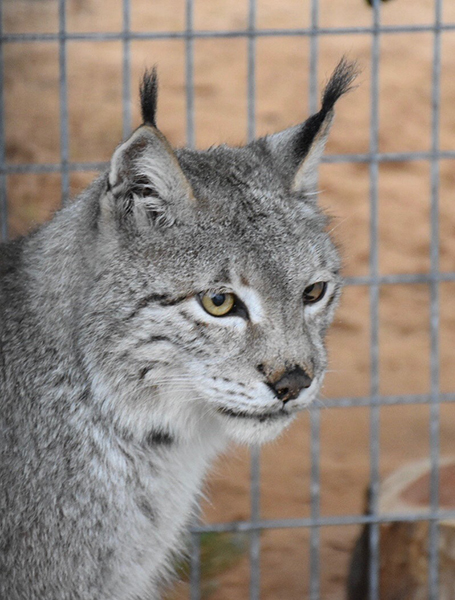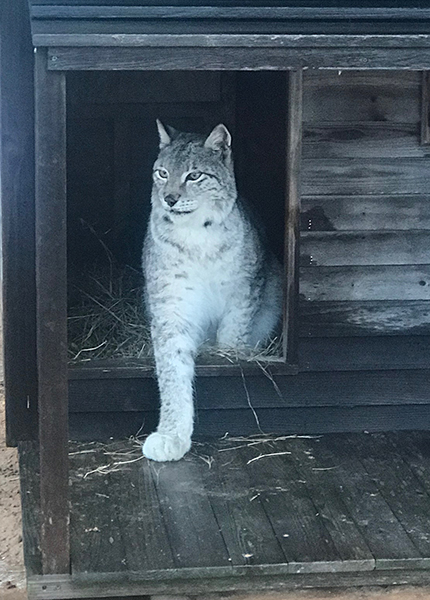Lynx Finds Fur-ever Home at Texas A&M Wildlife Center
Story by Megan Myers, CVMBS Communications

As the newest exotic animal resident of the Texas A&M College of Veterinary Medicine & Biomedical Sciences’ (CVM) Winnie Carter Wildlife Center, Kisa the lynx has found the purr-fect place to call home.
The 11-year-old Eurasian lynx came to Texas A&M’s Wildlife Center in February from a conservation breeding facility in Arkansas. Because Kisa (киса, in Russian, means “kitty”) is now considered “middle-aged,” she is retiring from conservation work and taking on the role of an ambassador species for Texas A&M’s Wildlife Center.
“She will be one of our educational animals; she will help teach students about the special routine care and feeding of exotic cats, including preventative veterinary care,” said Dr. Alice Blue-McLendon, director of the Winnie Carter Wildlife Center.
The Wildlife Center also cares for two other species of small exotic cats, a serval and three Asian leopard cats, so the addition of a lynx will increase the variety of learning opportunities for students and emphasize the differences between similar species.
“Even though the management of the species might be very similar, the animals’ behavior will be different,” Blue-McLendon said. “The animals have different personalities even though they may be similar in size.”
Kisa’s arrival also provided an opportunity for collaboration across colleges; soon after Blue-McLendon knew she would need to build a habitat for Kisa, she reached out to Dr. José Fernández Solís, an associate instructional professor of construction science at the Texas A&M College of Architecture, for help designing the perfect space.
“It’s really been fun to work with Dr. Solís because he just loves students and he loves to have projects,” Blue-McLendon said. “His input has been delightful and he has really understood that I wanted to do sustainable construction as best we could. He drew up some plans for us and had all kinds of interesting ideas.”
As the vice president of architecture at Lord Aeck Sargent, a design firm headquartered in Atlanta, Solís has experience designing exotic animal habitats from his work on a multilevel renovation and addition to the Atlanta Zoo’s orangutan habitat in 1996.
“No two wildlife projects are the same but all have a common theme—what is the natural habitat of the wildlife that can best be represented in a confined space?” Solís said.

For the Winnie Carter Wildlife Center’s lynx enclosure project, Solís’ design was based on a close collaboration with Blue-McLendon and Dave Goltz, director of the College of Architecture’s Automated Fabrication and Design Lab.
“We worked hand-in-hand to solve issues and develop alternative solutions that resulted in this new facility,” Solís said. “Vertical wire fence was embedded four to six inches into a steel reinforced-grade beam so neither the lynx nor any future exotic animal will be able to dig under.
“The collective interdisciplinary effort was very rewarding and interactive,” he said. “The design maximizes what a group of volunteer students could build with oversight from the Wildlife Center, Department of Construction Science, and additional supervisors.”
The creation of Kisa’s habitat was made possible thanks to the generosity of many who donated time, money, and resources. From concrete to cedar logs, most of the materials for the enclosure were freely given by people who wanted to support the Wildlife Center’s goal to give Kisa the best home possible.
Kisa’s finished enclosure is 2,000 square feet full of shelters, climbing objects, and several other forms of enrichment.
“One of the best enrichments is that she will have lots of people around all day long,” Blue-McLendon said. “She’s apparently been around humans her entire life and she likes the presence of people. Just providing lots of students to talk to her will be fantastic.”
Enrichment coordinators, the Wildlife Center’s new volunteer student positions, will be in charge of conducting research online and at other wildlife sanctuaries to find new ways to entertain Kisa as time goes on.
“They’ve already built one structure, a cedar log with another log coming out at an angle and they’re going to hang a PVC toy from it that’s wrapped in rope,” Blue-McLendon said. “I got the idea for this after visiting another wildlife facility recently; their leopard had one and absolutely loved it.”
Best of all, Kisa will have access to the best veterinary care from Blue-McLendon and other talented specialists at the CVM. Using training and the benefits of her custom enclosure, Kisa’s veterinarians will be able to regularly examine her to monitor her weight and health.
As Kisa settles into her new home, Blue-McLendon and veterinary students at the Wildlife Center are looking forward to getting to know her and seeing her personality bloom.
“We’re excited. It’s really fun to partner with people and get people excited about things,” Blue-McLendon said. “It’s been fun to interact with lots of different people who understand the mission of providing sanctuary for an animal for the rest of its life and allowing students to get exposure to things that they normally could not on a college campus.”
###
For more information about the Texas A&M College of Veterinary Medicine & Biomedical Sciences, please visit our website at vetmed.tamu.edu or join us on Facebook, Instagram, and Twitter.
Contact Information: Jennifer Gauntt, Director of Communications, Texas A&M College of Veterinary Medicine & Biomedical Sciences; jgauntt@cvm.tamu.edu; 979-862-4216


